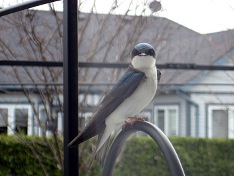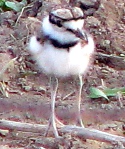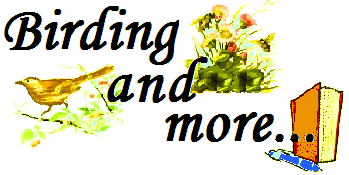 Newsletter
Newsletter
2010
/ Issue 8
IN THIS ISSUE: THE WARBLER MIGRATION
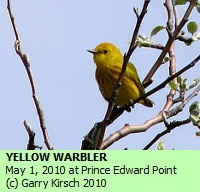
Warblers are beautiful, charming, vocal little birds, that are a joy to see. They are also very active and elusive. When it comes to bird photography, there's nothing I love more than the challenge of trying to capture them!
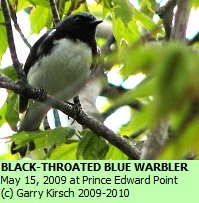 This
encompasses a fairly large number
of little birds including New
World Warblers, Old World
Warblers, Australian
Warblers, etc.
This
encompasses a fairly large number
of little birds including New
World Warblers, Old World
Warblers, Australian
Warblers, etc.For the purposes of this article (which deals with warblers in Southern Ontario) I will stick to Family Parulidae, or New World Warblers. Around here, most of these are from the Genus Dendroica, which includes the three warblers pictured on this page. All in all (if you include the Ovenbird) there are about 32 different warblers that you could see at Prince Edward Point .
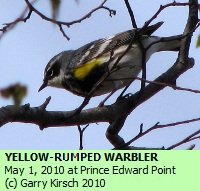
Personally I couldn't wait, so I went hunting for warblers yesterday at 'The Point'. It was great - except I forgot to take spare batteries for my camera - which shortened my day to about 2 hours - but it was a great two hours.
You can read all about it in my latest blog post entitled "Birding May Day".
Take it from me, there's nothing like going out into the woods and being surrounded by the sounds of warblers, and being filled with the anticipation of catching a glimpse of one of these beautiful little birds. So if you're living in the Belleville area, I recommend you get out to Prince Edward Point next weekend. If you're not in the Belleville area, there are lots of other great birding locations for spotting the Spring warblers, like Long Point, Point Pelee, Presqu'ile Provincial Park, to mention a few - in fact the warblers will be everywhere. So if you have a wildlife conservation area near you, do yourself a favour and go take a look for some of these great little birds as they pass through your region.
|
American Redstart |
Chestnut-sided Warbler |
Palm Warbler |
|
Bay-breasted Warbler |
Common Yellowthroat |
Pine Warbler |
|
Black-and-white Warbler |
Connecticut Warbler |
Prairie Warbler |
|
Blackburnian Warbler |
Hooded Warbler |
Prothonotary Warbler |
|
Blackpoll Warbler |
Kentucky Warbler |
Tennessee Warbler |
|
Black-throated Blue Warbler |
Magnolia Warbler |
Wilson's Warbler |
|
Black-throated Green Warbler |
Mourning Warbler |
Worm-eating Warbler |
|
Blue-winged Warbler |
Nashville Warbler |
Yellow Warbler |
|
Canada Warbler |
Northern Parula |
Yellow-rumped Warbler |
|
Cape May Warbler |
Orange-crowned Warbler |
Ovenbird |
|
Cerulean Warbler |
Yellow-throated Warbler |
READERS' PHOTOS
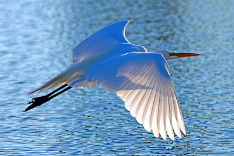
taken by Steve Shelasky
This beautiful backlit photo was taken at Eagles Lake in Naples, Florida at sunrise during the winter of 2010. It wasn't until Steve uploaded the image to his computer that he noticed the shadow of the Egret's head on the near wing!
***********************
Female Tree Swallow
taken by Barry Kant
Captured through the livingroom window, this gorgeous
swallow was perched on the frame of the deck cover, and looking directly at
Barry as he took the shot. Barry concluded this particular swallow was a
'female' based on how much time it spent in its birdhouse nest.
***********************
The Readers
Patch is
a space for your photos, stories, and/or comments.
Send anything
you'd like to share with us to: newsletter@birdingandmore.com
***********************
NAME THAT BIRD
Name this common Ontario bird, and win a free subscription to the Birding and
more... Newsletter!
![]()
Send your guess to garry@birdingandmore.com

A bird's feathers weigh more than its skeleton!
What's New this week
at www.birdingandmore.com
New posts added to the
Birding and more blog:
A
Bird Feeding Chart has been added to the website.
(Birds that have been renamed in recent years)
Old name New name
Rock Dove----------------Rock Pigeon
Oldsquaw----------------Long-tailed Duck
Northern Oriole----------Baltimore Oriole
Whistling Swan----------Tundra Swan
The beginning of May is also the beginning of the return of the Ruby-throated Hummingbirds! Any day now they will start to reach our area and begin scouring the region for food sources. Hummingbirds expend a tremendous amount of energy in flight. It's not easy flapping your wings at 80 times per second! So they need lots of high energy food - usually nectar or sugar water. They will search for this food everywhere, so get your hummingbird bird feeders out of storage - clean them thoroughly, and fill them with a sugar-water solution of 4 parts boiled water to one part sugar. If you don't already have a feeder and you'd like to attract some of these amazing little visitors, here are some suggestions. Buy a feeder with perches. As I mentioned, hummingbirds expend a lot of energy in flight, so give them a break when they visit your garden and provide a place for them to sit while they eat. Also,
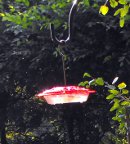 I
recommend the bowl style feeder. It is easy to clean, has a built-in ant moat,
and it won't drip like the gravity feed kind. This will help to keep the wasps
from finding the feeder and targeting it as their own food supply. It can also
take some time for the hummingbirds to find your feeder, so don't wait for it to
be emptied before you replenish the sugar-water. You should clean and refill
your feeder every four days, or so. Fresh food will keep the birds safe and keep
them coming back.
I
recommend the bowl style feeder. It is easy to clean, has a built-in ant moat,
and it won't drip like the gravity feed kind. This will help to keep the wasps
from finding the feeder and targeting it as their own food supply. It can also
take some time for the hummingbirds to find your feeder, so don't wait for it to
be emptied before you replenish the sugar-water. You should clean and refill
your feeder every four days, or so. Fresh food will keep the birds safe and keep
them coming back.May is just beginning but our garden is about a month ahead of last year (or at least two or three weeks) and I love walking around the yard searching for those favourite perennials I hope to see again. I much prefer perennials over annuals – for the most part, once they're planted they'll keep growing year after year with minimal maintenance.
We planted periwinkle throughout the garden that first Spring and I have to say I'm a little disappointed. It isn't spreading and covering the bare areas
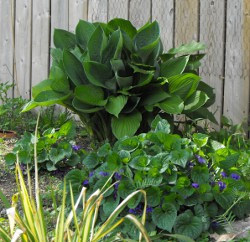 like I had envisioned but maybe I left too much ground for the few plants to
take care of. I also think our soil simply isn't good enough and maybe we need
to be adding compost.
Anyway, I'll plant a few more this year and see if they take. Meanwhile, the
Hosta I planted last year at the base of the neighbour's hedge (12 bare root
plants from those bargain multi-packs) are all coming up so I'm very pleased.
The three Hostas that a friend of ours gave us from her garden the first year,
planted next to the fence, are doing very well. We planted eight different
varieties of daylilies across the back and all of the plants are looking quite
luxuriant and healthy. This is their second summer so we're looking forward to
some beautiful flowers if they get enough sun.
like I had envisioned but maybe I left too much ground for the few plants to
take care of. I also think our soil simply isn't good enough and maybe we need
to be adding compost.
Anyway, I'll plant a few more this year and see if they take. Meanwhile, the
Hosta I planted last year at the base of the neighbour's hedge (12 bare root
plants from those bargain multi-packs) are all coming up so I'm very pleased.
The three Hostas that a friend of ours gave us from her garden the first year,
planted next to the fence, are doing very well. We planted eight different
varieties of daylilies across the back and all of the plants are looking quite
luxuriant and healthy. This is their second summer so we're looking forward to
some beautiful flowers if they get enough sun.We also have a number of other perennials scattered throughout the garden. We have several yuccas
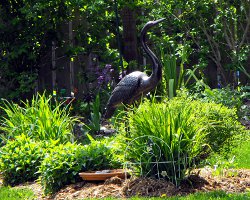 (one actually flowered last year!), violets, columbine, turtlehead,
wild geranium, catmint, astilbe, bleeding heart, coral bells, purple
coneflowers, black-eyed susans, bee balm, daisies, ferns, solomon's seal, meadow
rue, spiderwort, lungwort, blazing star, rayflower, red hot poker, money plant,
as well as a couple of virginia creeper vines and a honeysuckle vine climbing up
chicken wire attached to the fence. The coneflowers and bee balm are of
particular interest to the birds for their seed so we've made a point of
planting those in several different locations. Many of our plants are more like
wildflowers than “domesticated” and we love the natural look to our garden.
Based on the number of birds that take advantage of the shrubs, plants and
feeders we think they love it too!
(one actually flowered last year!), violets, columbine, turtlehead,
wild geranium, catmint, astilbe, bleeding heart, coral bells, purple
coneflowers, black-eyed susans, bee balm, daisies, ferns, solomon's seal, meadow
rue, spiderwort, lungwort, blazing star, rayflower, red hot poker, money plant,
as well as a couple of virginia creeper vines and a honeysuckle vine climbing up
chicken wire attached to the fence. The coneflowers and bee balm are of
particular interest to the birds for their seed so we've made a point of
planting those in several different locations. Many of our plants are more like
wildflowers than “domesticated” and we love the natural look to our garden.
Based on the number of birds that take advantage of the shrubs, plants and
feeders we think they love it too!If you liked our newsletter
please pass it along to your friends and family.
Subscriptions are free! Just send an
email to: newsletter@birdingandmore.com
If you wish to cancel your subscription send an email to unsubscribe@birdingandmore.com
